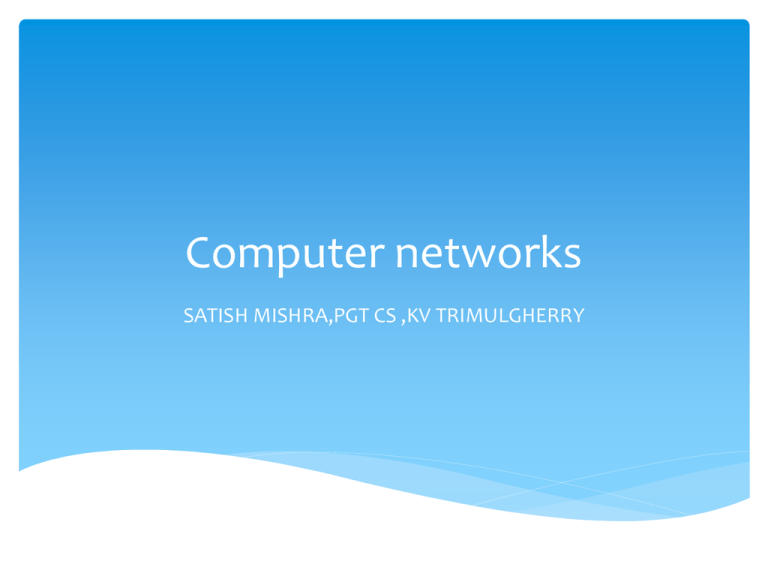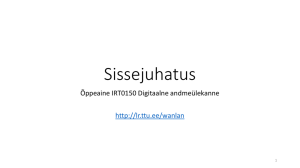Computer networks
advertisement

Computer networks SATISH MISHRA,PGT CS ,KV TRIMULGHERRY What is a computer Network? A network is any collection of independent computers that communicate with one another over a shared network medium. A computer network is a collection of two or more connected computers. Every network includes: At least two computers Server or Client workstation. Networking Interface Card's (NIC) A connection medium, usually a wire or cable, although wireless communication between networked computers and peripherals is also possible. Network Operating system software, such as Microsoft Windows NT or 2000, Novell NetWare, Unix and Linux. Types of Networks: LANs (Local Area Networks) WANs (Wide Area Networks) Internet Intranet MANs (Metropolitan area Networks) LANs (Local Area Networks) A network is any collection of independent computers that communicate with one another over a shared network medium. LANs are networks usually confined to a geographic area, such as a single building or a college campus. LANs can be small, linking as few as three computers, but often link hundreds of computers used by thousands of people. The development of standard networking protocols and media has resulted in worldwide proliferation of LANs throughout business and educational organizations. WANs (Wide Area Networks) Wide area networking combines multiple LANs that are geographically separate. This is accomplished by connecting the different LANs using services such as dedicated leased phone lines, dial-up phone lines (both synchronous and asynchronous), satellite links, and data packet carrier services. Wide area networking can be as simple as a modem and remote access server for employees to dial into, or it can be as complex as hundreds of branch offices globally linked using special routing protocols and filters to minimize the expense of sending data sent over vast distances. Internet The Internet is a system of linked networks that are worldwide in scope and facilitate data communication services such as remote login, file transfer, electronic mail, the World Wide Web and newsgroups. With the meteoric rise in demand for connectivity, the Internet has become a communications highway for millions of users. The Internet was initially restricted to military and academic institutions, but now it is a full-fledged conduit for any and all forms of information and commerce. Internet websites now provide personal, educational, political and economic resources to every corner of the planet. Intranet With the advancements made in browser-based software for the Internet, many private organizations are implementing intranets. An intranet is a private network utilizing Internet-type tools, but available only within that organization. For large organizations, an intranet provides an easy access mode to corporate information for employees. MANs (Metropolitan area Networks) The refers to a network of computers with in a City. Categories of Network: Network can be divided in to two main categories: Peer-to-peer. Server – based. In peer-to-peer networking there are no dedicated servers or hierarchy among the computers. All of the computers are equal and therefore known as peers. Normally each computer serves as Client/Server and there is no one assigned to be an administrator responsible for the entire network. Peer-to-peer networks are good choices for needs of small organizations where the users are allocated in the same general area, security is not an issue and the organization and the network will have limited growth within the foreseeable future. The term Client/server refers to the concept of sharing the work involved in processing data between the client computer and the most powerful server computer. Protocols: A computer communication protocol is a description of the rules computers must follow to communicate with each other. What is TCP/IP? TCP/IP is the communication protocol for communication between computers on the Internet. TCP/IP stands for Transmission Control Protocol / Internet Protocol. TCP/IP defines how electronic devices (like computers) should be connected to the Internet, and how data should be transmitted between them. TCP is responsible for breaking data down into IP packets before they are sent, and for assembling the packets when they arrive. IP is responsible for sending the packets to the correct destination. IP Addresses Each computer must have an IP address before it can connect to the Internet. Each IP packet must have an address before it can be sent to another computer. This is an IP address: 192.68.20.50 This might be the same IP address: www.google.com An IP Address Contains 4 Numbers. Each computer must have a unique IP address. This is your IP address: 180.215.112.16 TCP/IP uses four numbers to address a computer. The numbers are always between 0 and 255. IP addresses are normally written as four numbers separated by a period, like this: 192.168.1.50 32 Bits = 4 Bytes In computer terms, TCP/IP uses 32 bits addressing. One byte is 8 bits. TCP/IP uses 4 bytes. One byte can contain 256 different values: 00000000, 00000001, 00000010, 00000011, 00000100, 00000101, 00000110, 00000111, 00001000 .......and all the way up to 11111111. Now you know why a TCP/IP address is four numbers between 0 and 255. Domain Names A name is much easier to remember than a 12 digit number. Names used for TCP/IP addresses are called domain names. www.google.com is a domain name. When you address a web site, like http://www.w3schools.com, the name is translated to a number by a Domain Name Server (DNS). All over the world, DNS servers are connected to the Internet. DNS servers are responsible for translating domain names into TCP/IP addresses. When a new domain name is registered together with a TCP/IP address, DNS servers all over the world are updated with this information. Trace your IP http://www.tracemyip.org/ Locate 69.63.176.11 http://www.ip-adress.com/ip_tracer/ HTTP - Hyper Text Transfer Protocol HTTP takes care of the communication between a web server and a web browser. HTTP is used for sending requests from a web client (a browser) to a web server, returning web content (web pages) from the server back to the client. HTTPS - Secure HTTP HTTPS takes care of secure communication between a web server and a web browser. HTTPS typically handles credit card transactions and other sensitive data. SMTP - Simple Mail Transfer Protocol SMTP is used for transmission of e-mails. The SMTP protocol is used for the transmission of emails. SMTP takes care of sending your email to another computer. Normally your email is sent to an email server (SMTP server), and then to another server or servers, and finally to its destination. POP - Post Office Protocol The POP protocol is used by email programs (like Microsoft Outlook) to retrieve emails from an email server. If your email program uses POP, all your emails are downloaded to your email program (also called email client), each time it connects to your email server. NIC(NETWORK INTERFACE CARD) In computer networking, a NIC provides the hardware interface between a computer and a network. A NIC technically is network adapter hardware. In new computers, NICs are now pre-installed by the manufacturer. All NICs feature a speed rating such as 11 Mbps, 54 Mbps or 100 Mbps that suggest the general performance of the unit. How does internet works ? http://www.youtube.com/watch?v=i5oe63pOhLI&feat ure=related Questions ??








